Midrange CPU Roundup: It's Time to Buy
by Anand Lal Shimpi on September 28, 2007 2:00 AM EST- Posted in
- CPUs
General Performance
SYSMark 2007 takes 14 current desktop applications and runs groups of them through four different scenarios categorized by BAPCo as E-Learning, Video Creation, Productivity, and 3D.
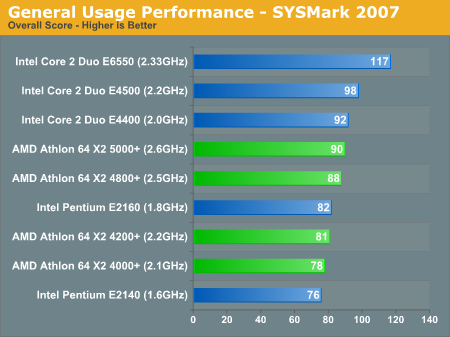
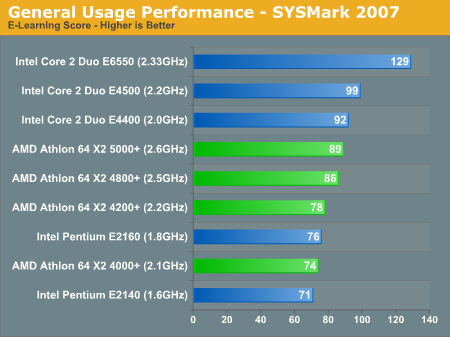
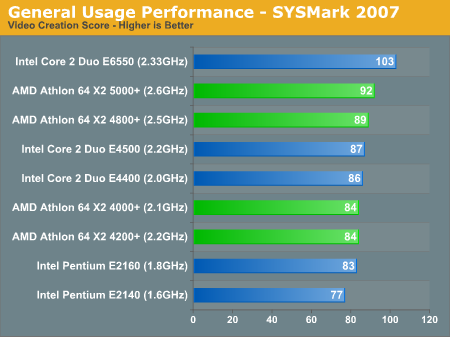
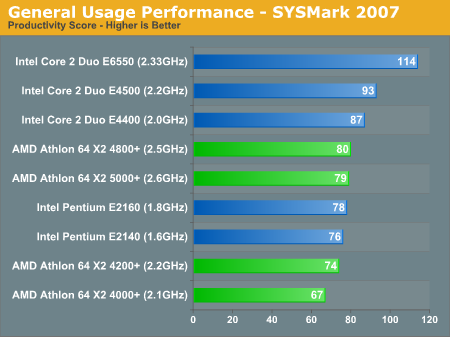
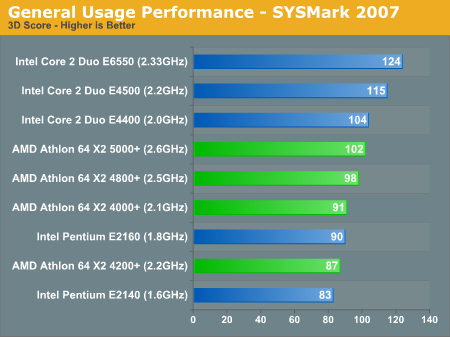
Overall performance is slightly in Intel's favor when we look at the matchups we outlined at the beginning of the article. The Core 2 Duo E4500 is slightly faster than the Athlon 64 X2 5000+, but the margin of victory shrinks considerably when we look at the E4400 vs. Athlon 64 X2 4800+. The difference between the E4500 and E4400 is 200MHz, or about 10%, while the difference between the 5000+ and 4800+ is only 100MHz and less than 4% of the clock speed of the 5000+, resulting in a narrowing gap as we head down in price on Intel's side. For all intents and purposes, the Core 2 Duo E4400 is the same speed as the Athlon 64 X2 4800+, and on the AMD side there's no real reason to purchase the 5000+ as it doesn't really offer a tangible performance advantage over the slightly cheaper 4800+.
The race is also close at the very low end. The Athlon 64 X2 4000+ (and X2 BE-2350) is very close to the Pentium E2160 in performance, although Intel gets the slight edge. Unlike competition at the higher end of the CPU spectrum, AMD and Intel are neck and neck with their mainstream CPUs in general usage.
SYSMark 2007 takes 14 current desktop applications and runs groups of them through four different scenarios categorized by BAPCo as E-Learning, Video Creation, Productivity, and 3D.





Overall performance is slightly in Intel's favor when we look at the matchups we outlined at the beginning of the article. The Core 2 Duo E4500 is slightly faster than the Athlon 64 X2 5000+, but the margin of victory shrinks considerably when we look at the E4400 vs. Athlon 64 X2 4800+. The difference between the E4500 and E4400 is 200MHz, or about 10%, while the difference between the 5000+ and 4800+ is only 100MHz and less than 4% of the clock speed of the 5000+, resulting in a narrowing gap as we head down in price on Intel's side. For all intents and purposes, the Core 2 Duo E4400 is the same speed as the Athlon 64 X2 4800+, and on the AMD side there's no real reason to purchase the 5000+ as it doesn't really offer a tangible performance advantage over the slightly cheaper 4800+.
The race is also close at the very low end. The Athlon 64 X2 4000+ (and X2 BE-2350) is very close to the Pentium E2160 in performance, although Intel gets the slight edge. Unlike competition at the higher end of the CPU spectrum, AMD and Intel are neck and neck with their mainstream CPUs in general usage.










44 Comments
View All Comments
Darth Farter - Friday, September 28, 2007 - link
why not the cool & quiet idle power numbers?seeing they're running at full speeds at idle is besides the point of an "idle" measurement in this age with powersavings...
tnx though on the bios update request from asus... I want to tweak my timings too.
Anand Lal Shimpi - Friday, September 28, 2007 - link
C&Q and EIST were both enabled for the idle and load power numbers. Actually all the benchmarks were run with those settings enabled.Take care,
Anand
archcommus - Friday, September 28, 2007 - link
I realize the benchmarks are run at 1024x768 to make the tests CPU-limited, does that mean all, or at least most, of the extra horsepower needed for resolutions above that comes from the GPU? If so, does that mean I could run games at 1280x1024 well with a high-end card and one of the AMD CPUs from this round-up? Or would that be a bad match-up? If that would work it's an appealing upgrade path alternative to jumping platforms.nosfe - Friday, September 28, 2007 - link
why not color code those performance graphs so that we can easily see which processors are competing at the same price